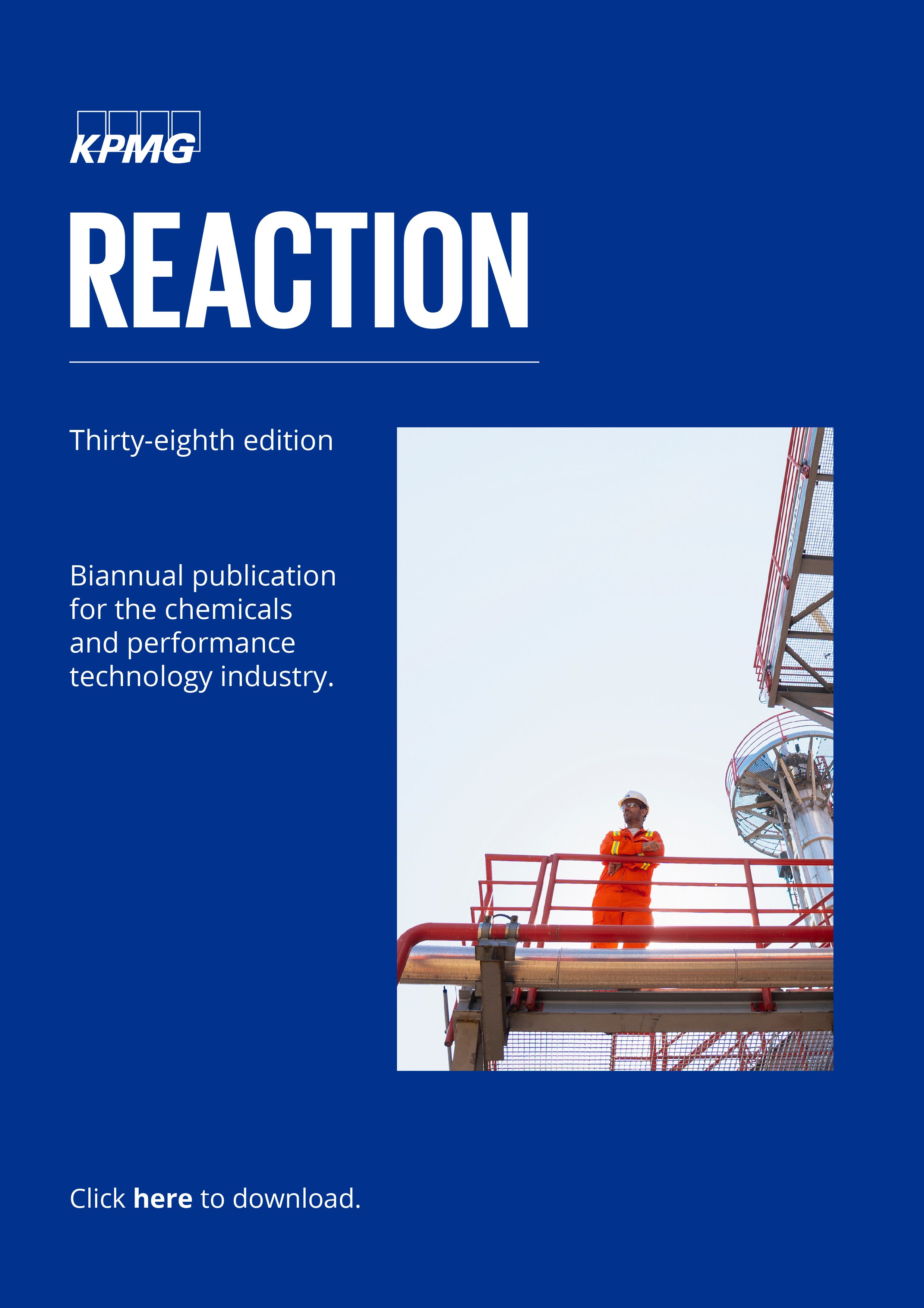By: Ed Coleman, Partner, Business Tax Services – Strategic Corporate Chemicals Deputy National Tax Industry Leader, KPMG in the US; Carlo Franchina, Global Energy & Natural Resources Tax Leader, KPMG International and National Leader, Corporate Tax — Non-Financial Services, KPMG; Australia Hannah Hawkins, Principal, Credits & Incentives, Washington National Tax, KPMG in the US; and ; Timothy A A Stiles, Special Envoy for KPMG ESG, KPMG in the US.
Although the primary purpose was to combat inflation, the Inflation Reduction Act (IRA), signed into law by President Biden in August 2022, also dramatically recast the landscape for green investment in the US. The starting gun has been fired – and players in the chemicals industry need to ensure they are positioned to take advantage of the many incentives.
The Act creates a comprehensive and substantial package of tax credits, benefits and incentives for investments that further the energy transition towards a low-carbon future as the US pursues its net zero agenda. These credits are wide-ranging and varied. They could cover an investment in a new manufacturing or industrial facility or an upgrade to an existing facility. They apply to investments in clean energy such as wind and solar. They also incentivize carbon capture technologies and energy-efficient steam, heat and power processes. Many different products and methods could be eligible, including manufacturing products that will become a component of another green asset – for example, a chemical business making a substance that will be used in an EV automotive battery.
Understanding the detail
Because it is so broad, the IRA holds enticing potential for organizations across many sectors and industries. A manufacturing or industrial business could benefit significantly from aligning with the Act's aims and provisions. If a business’s existing or planned products or processes align with the Act's purposes and conditions, a chemical organization might find itself positioned to benefit from some of these incentives. This can range from production activities supporting the clean energy supply chain to investments in renewable energy sources powering its operations.
As the size of available tax credits can vary significantly based on several factors, it is critical to understand the details, such as how much the technologies and processes in question reduce greenhouse gas emissions. For example, looking at hydrogen production, the full base credit is available only for clean hydrogen processes that generate less than 0.45 kilograms of carbon dioxide equivalent greenhouse gases (CO2e) for each kilogram of hydrogen. For those which generate 0.45 to 1.5 kilograms of CO2e, just a third of this credit is available.1
The Act also significantly expands the Section 45Q tax credits2 available for carbon capture, utilization and storage (CCUS). Carbon capture can be used to reduce emissions across a diverse range of industries and can help organizations plan toward carbon reduction goals. But again, the level of credit depends on the technology used. While the standard credit is up to $85 per tonne of CO2 permanently stored and US$60 per tonne of CO2 used for enhanced oil recovery (EOR), the credit for direct air capture (DAC) increases to US$180 per tonne of CO2 permanently stored and US$130 per tonne for used CO2. Other factors that aim to support local economies and workers across the US, discussed below, will also significantly impact a project’s tax credits.
The good news doesn’t end there. In addition to the available tax credits, there are also potential grants for businesses to fund specific activities (such as opening a new factory or facility). Many of these location and expansion credits are offered at a state and local level as jurisdictions compete to attract investment and local jobs.
More than one benefit or incentive may be available on the same activity – and as the detail has been digested since the IRA was published, there has been growing interest in how incentives can be ‘stacked’ or layered on top of each other to supercharge the benefit.
Tax credit trading
In a further innovative move, the tax credits available may also be sold to a third party or (in some cases) refundable – that is, taken as a direct cash payment from the government rather than held and offset against that year’s tax liability. There could be an active market for tax credit trading. Credits will most likely trade at a discount, although it is hard to predict the exact reduction. Refundable and transferable tax credits look attractive and will make it easier for an organization to access the economic benefits of the credits. Their introduction will likely lead to growing investment in these areas, helping companies seeking financing for such projects.
However, potential participants are proceeding cautiously as many questions remain regarding the market’s liquidity for trading credits. At the time of publication the Internal Revenue Service (IRS) has yet to publish details of how transferability and direct pay of tax credits will be administered, but guidance is expected later this year.
Questions of timing
Another consideration is timing. For example, to qualify for the hydrogen production tax credit and credit for carbon oxide sequestration, construction of the facility needs to start by the end of 2032. In contrast, other provisions sunset earlier or have phaseouts. Careful attention should be paid to these dates when constructing project timelines.
While tax credits will be available to all qualifying investments within the qualifying period, it is worth remembering that some of the grants available will likely take the form of a finite pool of money – available while funds last and on a first-come, first-served basis! Time may be of the essence to apply for specific grants before funding is exhausted, and there may also be a competitive element as companies effectively bid against each other for a slice of the pie.
Promoting the American economy
Meanwhile, some tax incentives are linked to the location of projects and suppliers, workers’ pay and the development of apprenticeship programs as further mechanisms to support and bolster the American economy, jobs and living standards. For instance, in some cases, higher credit rates are available if credit-eligible projects are constructed using certain levels of American-made components. In addition, the electric vehicle tax credits now include new requirements for assembling and sourcing battery components and critical minerals. The way these provisions impact the US supply chain will be closely watched.
In many cases, qualifying facilities must be constructed and maintained by workers earning the prevailing wage and with a certain number of apprentices to qualify for the highest available credit rates. But compliance is likely to be a key challenge in meeting apprenticeship and prevailing wage requirements. Companies need to be able to document and demonstrate satisfaction with the rules by leveraging data of contractors and subcontractors they may have never had to track before.
Not just a tax play
The dust has begun to settle after the excitement of the initial news. Businesses are beginning to develop their understanding of the potential of IRA for them – and if they haven’t done so yet, they need to catch up fast. We don’t yet have guidance from the IRS on how various rules will be applied, but that will come in time and shouldn’t hold organizations back from assessing the IRA thoroughly regarding its implications for future investment strategy and planning.
One critical aspect is that the impact of the Act extends much broader than the tax team. When considering IRA, it’s vital that different parts of the organization are linked up and talking to each other – tax, sustainability, operations, finance, accounting, planning, investment, and indeed the C-suite. The implications – and potential benefits – are pervasive and should be a matter of internal collaboration and analysis.
One critical aspect is that the impact of the Act extends much broader than the tax team.
International perspectives
The Act's incentives only apply to activities and developments within the US itself, so they would not apply to a US company investing in a new site or operation overseas. On the flip side, the Act has increased interest from international businesses in investing in the US. Interest is genuinely global as industry leaders discussed the Act at the recent World Petrochemical Conference in Houston, where non-US executives almost universally praised it for being well-drafted, thought-out, market-based legislation. The effects of the Act could be felt for years to come in the form of an increase in international investment into the US in the chemicals sector. The US is already a premium destination for businesses worldwide – IRA looks set to cement that and take it to an even higher level.
Certainly, the IRA must be seen as legislation with global significance rather than simply as a piece of domestic rulemaking. It aims to accelerate the US’s journey towards net zero and make it a global leader in tackling climate change.
EU Green Deal and cross-border carbon charges
By: Nicole de Jager, Global ESG Tax (EU Green Deal & Decarbonization), KPMG International, and Senior Tax Manager, KPMG in the Netherlands
The EU has set the ambitious target of becoming the world’s first climate-neutral continent by 2050. To achieve this, the European Commission (EC) has developed ambitious European Green Deal (EGD) climate targets that underpin EU member states’ commitment to a green transition. These targets are enforced through various policies, regulations and legislations. One key regulatory aspect of the EGD that has significant implications for businesses outside the EU is the pending commencement of the Carbon Border Adjustment Mechanism (CBAM), which will operate by imposing a charge on the embedded carbon content of certain imports, such as iron, steel, cement, fertilizers, hydrogen, aluminum and electricity3 that is equal to the charge imposed on the production of domestic goods under the EU Emissions Trading System (net of free permits), with adjustments being made to this charge to consider any mandatory carbon prices in the exporting country. By imposing an equivalent carbon price on covered goods imports, the playing field is leveled for both EU producers and EU importers of such goods, as partner countries are encouraged to decarbonize their production processes.
Although various subsidies and funding programs under the EGD support the transition to a green economy, such as the EU Green Chemistry Subsidy program that provides financial support for research, development and innovation projects in the field of green chemistry, the promulgation of the IRA prompted the EU to reassess its green industrial policies, explicitly concerning incentives and funding. Amid fears that the IRA would drive business across the Atlantic and increase EU domestic capability in clean energy technology and industries at a time of growing competition for these globally, the European Commission presented, on 1 February 2023, its Green Deal Industrial Plan (GDIP) for the net-zero age. The GDIP seeks to make it easier for sustainable companies to access tax breaks, redirect cash toward clean-tech industries and relax state aid rules.
Within the GDIP is the proposed Net Zero Industry Act (NZIA), which will focus on reducing emissions using cleaner technologies and processes, such as renewable energy sources and energy efficiency measures, the promotion of green public procurement, increased support for research and development of new green technologies, and the incentivization of green investments. The NZIA also seeks to create a more circular economy by promoting the reuse and recycling of materials and encouraging the development of green products and services. To help ensure a fair transition to a net-zero economy, the Act will provide financial and technical support to those most affected by the transition, including support for retraining and upskilling workers and financial resources for businesses that need to invest in green technologies.
While there are no provisions in the proposed NZIA that are specifically geared towards the chemicals industry, it provides chemicals companies with several incentives for investment in emissions reduction and the development of clean technologies:
- Grants and loans for research and development of new technologies to reduce emissions and increase efficiency
- Tax credits for energy efficiency and renewable energy investments
- Tax incentives for businesses to reduce greenhouse gas emissions
- Financial incentives for businesses that convert to cleaner production processes
- Support for the adoption of green chemistry and sustainable materials
Although the GDIP sets out a $270 billion investment to support the European industrial sector's transition to a low-carbon economy, a direct comparison between the GDIP, NZIA and IRA cannot yet be made. The GDIP and NZIA are still in the early legislative stages and need to contain specific details regarding the nature and amount of tax credits, tax incentives and financial support.

US Superfund Excise Tax
Although it is challenging to compare regulatory models between jurisdictions, when considering an investment strategy on an international or global basis, chemical businesses will undoubtedly want to consider the tax and legal frameworks in each region as a crucial part of their decision-making process.
It is also worth noting that while the IRA is almost wholly a 'carrot,' some sticks are wielded simultaneously through separate pieces of legislation. Most notably, shortly before the IRA was enacted, the US administration reinstated the long-dormant Superfund Excise Tax, which has relevance to the chemicals, gas and petroleum industries.
Many taxable chemicals and hazardous substances are listed under the law. And whereas under the original Excise Tax (which expired in 1995), substances containing 50% or more of a listed chemical were taxable, that threshold has been reduced to 20%.4 The requirements may be more significant as an administrative burden than a financial one; to comply, companies will need to analyze the chemical composition of all their products along their supply chain and identify whether and at what point any taxable chemicals or substances are introduced.
Next Steps
Through the Act, enormous opportunities lie in front of chemical companies. It is imperative to ensure that businesses are positioned to leverage this potential fully.
The first step in this is to start a dialogue and analysis across all key functions in the business which have a stake in the IRA’s provisions; then, the organization needs to build a complete picture of the potential for the organization and how it will play into strategic, operational, financial, and ESG ambitions. Detailed questions may include:
- What tax credits and incentives are available through the IRA map for activities the organization is planning?
- Do any available incentives change the thinking and bring new possible investments into play?
- Could tax credit trading hold commercial potential for the business?
- Can internal structuring and transfer pricing related to credits provide additional financial benefits?
- What grants and incentives are available, in which locations, and what are the application deadlines? Which states may be most attractive to the business to locate activities?
- How do stipulations around workers’ pay and apprenticeships affect commercial operations and financial results?
The considerations should be holistic and include a view of the broader international landscape related to the organization’s investment and operational choices:
- Does the IRA make the US the automatic go-to destination for future activity?
- What impact will the Superfund Excise Tax have?
- What does a comparison of the US regime with that of other regions, such as the EU show, and how does this impact future strategy?
There are many aspects to think about and important decisions to be made. KPMG firms have an extensive team of IRA and chemicals specialists who can advise US and foreign businesses on the options and choices ahead of them and some of the all-important detail that could make the difference to the decisions made.
It would be their pleasure to discuss this with you. Please get in touch if you would like to learn more about the IRA.
Related insights
Get in touch
1 KPMG, “Inflation Reduction Act” Tax Law Changes Special Report, August 2022
2 KPMG, Section 45Q Credit for Carbon Oxide Sequestration, January 2022
3 In the early stages of CBAM's implementation, the chemicals industry is directly impacted in relation to the importation of hydrogen and chemical fertilizers to the EU. Upon importation, non-EU organizations must provide product-specific information on the embedded emissions contained within those affected goods imported
4 Thompson Reuters, How does the U.S’s new Superfund Excise Tax impact European businesses, October 2022, https://tax.thomsonreuters.co.uk/news/tax-news/indirect-tax-news/how-does-the-new-superfund-excise-tax-impact-european-businesses/











